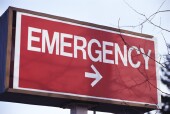
TUESDAY, March 19 (HealthDay News) — Some U.S. states have proposed denying Medicaid payments in cases where emergency department visits turn out to be “non-emergencies,” but a new study highlights the flaws in that plan.
The problem, the researchers report, is that even when an ER patient’s condition turns out to be minor, the initial symptoms are usually ambiguous: chest pain, abdominal pain, high fever. These are all symptoms that could spell serious trouble, or be something much milder.
And it’s unreasonable to expect the average person to know what those symptoms mean before heading to the ER, said study author Dr. Maria Raven, an assistant professor of emergency medicine at the University of California, San Francisco.
“You can have two people who come into the ER with the same symptoms, and one will turn out to have a life-threatening illness and the other has a minor illness,” said Raven.
If a 65-year-old man wakes up with chest pain, Raven explained, “the only reasonable thing to do” is to get to the ER. If it ends up that he only has a severe case of heartburn, he — and the ER — shouldn’t be penalized, she argued.
Raven said recent policy moves in some U.S. states were the motivation for her team’s study, which appears in the March 20 issue of the Journal of the American Medical Association.
Several states, including Washington, Tennessee, Iowa and New Hampshire, have considered or passed new Medicaid rules that limit payments for ER visits that turn out to be non-emergencies, based on patients’ discharge records.
So, Raven’s team used information on nearly 35,000 U.S. ER visits in 2009, to see if discharge diagnoses are a fair way to gauge whether a patient’s ER trip was justified.
They found that only 6 percent of the ER visits ended with diagnosis that could have been handled by a primary care doctor. And even then, the patients’ initial symptoms were the same as those for 89 percent of all people who came to the ER.
An ER doctor not involved in the study said the idea of denying Medicaid payments based on patients’ final diagnosis is not justifiable.
“One of the great myths in health care is that we have all these people using the ER as their primary care provider. But it’s just not true,” said Dr. James Adams, chair of emergency medicine at Northwestern University in Chicago, who wrote an editorial that accompanied the study.
And ER patients who end up with minor diagnoses are not where the big costs are anyway, Adams said.
Instead, he explained, it’s with the people who come to the ER frequently with serious health complaints.
Between 4.5 percent and 8 percent of ER patients are “frequent users” — accounting for about one-quarter of all U.S. ER visits, Adams explained in his editorial.
Often, he said, those patients are mentally ill, homeless or have other serious problems, but no social support. “These are the people who keep coming back to the ER again and again until someone helps them, or until they die,” Adams said.
Both he and Raven said that focusing on something narrow, like Medicaid payments for certain ER diagnoses, is unlikely to save the program much money even if it could be done fairly. “And I don’t think it is possible,” Raven noted.
When it comes to the problem of “frequent users,” Adams said he doesn’t think it would take huge changes to see improvements. Better coordination among ERs and local social services could make a big difference, he suggested.
“We could reorganize the delivery of care for just these patients,” Adams said. “That would take bringing together agencies that already exist.”
Raven said that focusing on one area of ER care for cost-cutting is unlikely to yield much savings anyway. According to the American College of Emergency Physicians, all ER costs together account for less than 2 percent of the nation’s $2.4 trillion in health care expenses each year.
More information
The American College of Emergency Physicians has information on the costs of ER care.

